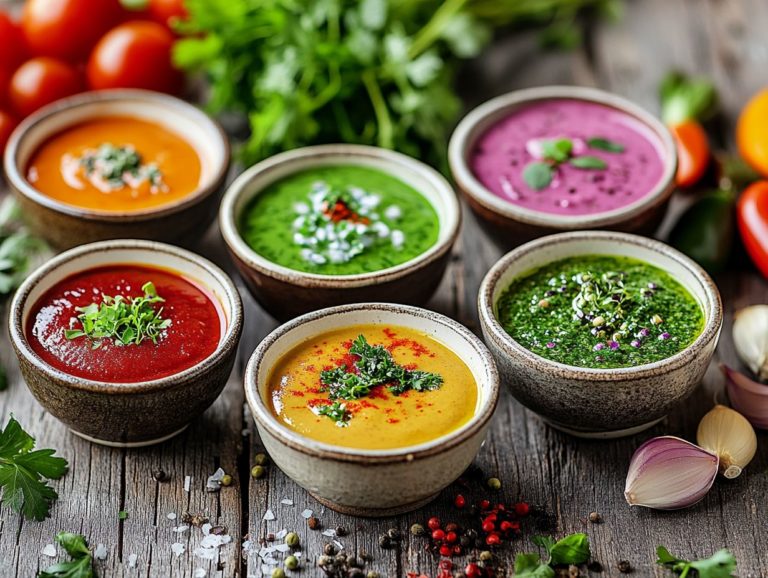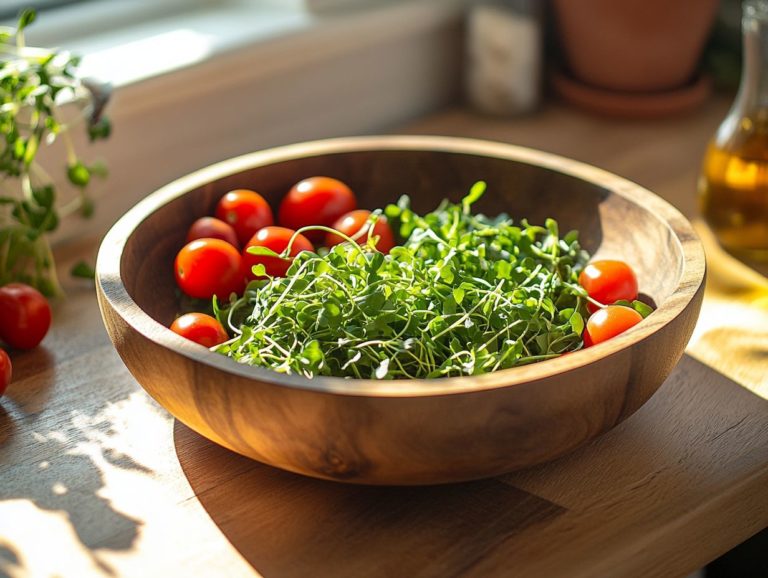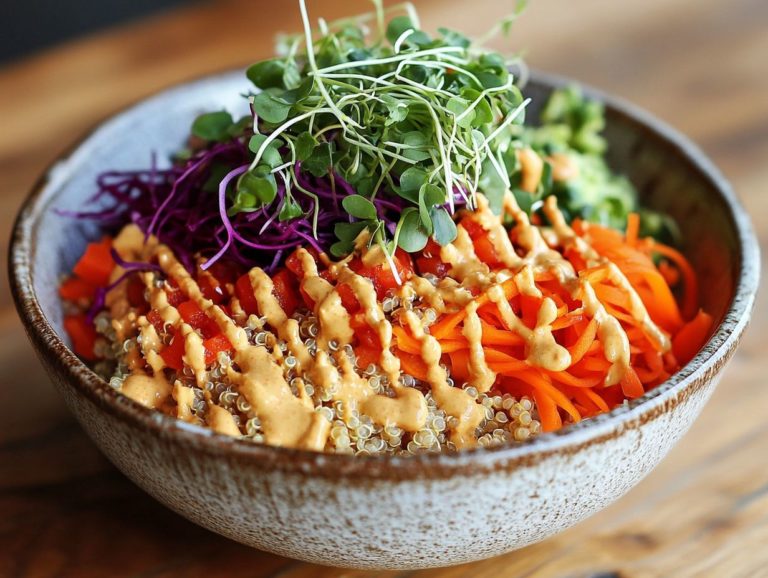76. Microgreens in Fusion Cuisine: Creative Uses
Microgreens are nutritious plants that pack a flavor punch, making them an exceptional addition to the modern culinary scene.
In this article, you ll dive into the vibrant world of microgreens and discover their myriad benefits, particularly in fusion cuisine. These petite plants elevate the nutritional value and flavor, inspiring innovative dishes that transform traditional recipes into something truly extraordinary.
Get ready to learn how to grow and harvest your own microgreens, complete with tips for incorporating them into your cooking. Elevate your culinary creations to new heights!
Contents
- Key Takeaways:
- Benefits of Incorporating Microgreens into Fusion Cuisine
- Creative Uses of Microgreens in Fusion Cuisine
- How to Grow and Harvest Microgreens
- Tips for Using Microgreens in Fusion Cuisine
- Frequently Asked Questions
- What are microgreens and how are they used in fusion cuisine?
- What makes microgreens a popular choice in fusion cuisine?
- What types of microgreens are commonly used in fusion cuisine?
- Can microgreens be grown at home for personal use in fusion cuisine?
- What are some creative uses of microgreens in fusion cuisine?
- Are there any health benefits to incorporating microgreens into fusion cuisine?
Key Takeaways:

- Microgreens are nutritious and add bold flavors to fusion cuisine.
- Expand your culinary horizons with unique flavor combinations using microgreens.
- Growing microgreens is simple and can be done at home.
What are Microgreens?
Microgreens are small yet powerful plants harvested at just the right moment typically between 7 to 21 days after germination. They are bursting with flavor and packed with health benefits.
You can toss them into salads, layer them in sandwiches, or use them as a soup garnish. They enhance both the look and nutrition of your meals.
Rich in essential nutrients, microgreens fit seamlessly into cuisines around the globe, from Asian stir-fries to Mediterranean specialties. You don t need vast resources or ample space to cultivate these nutrient powerhouses. Whether you opt for soil or hydroponics (growing plants without soil), anyone can nurture them right at home.
Varieties like radish, mustard greens, and kale stand out for their bold flavors and health benefits, contributing antioxidants, vitamins, and minerals that enhance your diet. Research shows microgreens pack several times more nutrients than their mature counterparts, making them a savvy addition to your everyday meals and gourmet masterpieces.
Benefits of Incorporating Microgreens into Fusion Cuisine
Using microgreens in fusion cuisine offers many benefits. They enhance flavor and add visual appeal to dishes.
These petite greens are perfect for both gourmet creations and everyday meals. Their vibrant colors and unique textures turn standard recipes into extraordinary experiences.
As you explore various culinary traditions, microgreens provide an innovative way to connect different flavor cultures while boosting the nutritional content of your offerings. They captivate both health-conscious diners and culinary enthusiasts alike.
Nutritional Value and Flavor Enhancement
Microgreens catch your eye and your palate, boasting impressive nutritional content that often surpasses their mature counterparts in vitamins, minerals, and antioxidants. This nutritional density, paired with their concentrated flavors, makes them a prized ingredient in a myriad of dishes.
Varieties like radish and mustard greens offer a delightful peppery kick. Meanwhile, pea shoots bring a gentle sweetness to the table. By incorporating these nutrient-rich microgreens into your recipes, you elevate the taste and boost your health in a delicious way.
Consider microgreens such as broccoli, kale, and sunflower, each packed with essential nutrients like vitamins C, E, and K. They also contain beneficial plant compounds that support overall health. Their petite size belies their ability to deliver bold flavors, transforming simple dishes into gourmet delights.
For instance, tossing arugula microgreens into a savory omelet introduces a sharpness that perfectly balances the richness of the eggs. Adding beet greens to a vibrant smoothie not only enhances its nutritional profile but also adds a visually stunning touch.
Embracing a variety of microgreens in your culinary endeavors opens up a world of possibilities. You can enjoy nourishment and delightful flavor contrasts in every bite.
Creative Uses of Microgreens in Fusion Cuisine

The creative ways you can use microgreens in fusion cuisine are truly limitless. This gives you the perfect opportunity to experiment and innovate in the kitchen while enjoying the health benefits of these tiny powerhouses.
Imagine adding a vibrant burst of color and flavor to your traditional dishes. You can craft unique sauces and garnishes that take your meals to the next level. Whether you’re looking to enhance a classic salad with lively basil or elevate a gourmet taco with the peppery kick of arugula, the versatility of microgreens opens a world of possibilities for your recipes. Explore how to enjoy microgreens beyond the plate to elevate your culinary creations.
As you explore innovative ways to incorporate these greens, you ll be at the forefront of redefining culinary boundaries.
Incorporating Microgreens into Traditional Dishes
Incorporating microgreens into your traditional dishes creates exciting twists that elevate both flavors and nutritional value. You ll love how these tiny greens fit right into salads, enhancing crisp textures and vibrant colors. They also make great toppings for soups, sandwiches, and wraps, providing that perfect fresh crunch.
For instance, using microgreens like radish or mustard in a classic potato salad not only adds a peppery kick but also boosts its nutritional content. As you explore various cooking techniques, think about how microgreens can complement your favorite recipes, making them healthier and more visually appealing.
Consider the delightful addition of pea shoots to a savory quiche. Their sweet, garden-fresh flavor pairs wonderfully with the richness of custard and cheese. Picture tossing vibrant beet microgreens into classic risotto; this enhances the dish’s color and adds a subtle earthy note. If seafood is your thing, cilantro microgreens are perfect for garnishing ceviche, delivering a burst of freshness that elevates the entire dish. To learn more about these and other varieties, check out exploring microgreen varieties in different cuisines.
With a wide array of options such as basil for Italian recipes, sunflowers for hearty sandwiches, and arugula for a zesty kick these greens amplify taste and enrich your meals with essential vitamins and antioxidants.
Try adding microgreens to your next meal and discover a burst of flavor and health benefits!
Creating Unique Flavor Combinations
Creating unique flavor combinations with microgreens can truly elevate your dishes, transforming simple ingredients into a remarkable cooking experience. The diverse flavors of microgreens like the peppery kick of arugula or the subtle sweetness of pea shoots empower you to craft innovative pairings that delight the palate.
Blend these greens now and transform your favorite dishes! You can incorporate them into sauces, smoothies, or even cocktails, adding a fresh twist to familiar favorites. For example, a refreshing garnish of mint microgreens can elevate a classic vodka cocktail into a gourmet delight, showcasing their versatility in both savory and sweet applications. Explore unique microgreens to elevate your dishes for even more creative ideas!
Incorporating these vibrant greens can take your leisurely brunch to the next level. Picture a delicate omelette adorned with crunchy beet microgreens, introducing not just texture but a hint of earthiness. When it comes to salads, combining radish and sunflower microgreens offers a spicy twist, while a sprinkle of cilantro microgreens provides a zesty finish. To further explore how these greens have transformed culinary practices, check out the evolution of microgreen varieties in cuisine.
For adventurous mixologists, adding basil microgreens to a mojito offers a unique flavor profile that redefines traditional recipes. The creativity with microgreens seems boundless, inspiring both home cooks and professionals alike to experiment and uncover new culinary delights, especially when exploring cooking with microgreen varieties.
How to Grow and Harvest Microgreens
Growing and harvesting microgreens presents a rewarding opportunity that you can pursue indoors or outdoors. This endeavor provides both novice and seasoned gardeners a straightforward way to cultivate healthy greens.
With simple techniques and systems like soil-based or growing plants in water without soil you can grow a diverse array of microgreens right in the comfort of your home.
These nutrient-dense plants require minimal space and time, making them ideal for those living in urban environments or anyone with limited gardening experience.
To embark on your microgreens journey, grasp the best practices for sowing, nurturing, and harvesting these tiny powerhouses.
Step-by-Step Guide

Follow this step-by-step guide to effortlessly cultivate microgreens at home, ensuring you savor fresh greens brimming with flavor and nutrition.
Start by selecting microgreens that suit your taste think basil, cilantro, or mustard greens tailoring your choices to your culinary adventures. Next, gather your materials: trays, quality soil, and seeds to establish your microgreens system.
Be attentive to essential factors like light, temperature, and moisture to create an ideal environment for growth. Harvest your microgreens when they reach the sweet spot of 1-3 inches for the best flavor and texture.
Selecting varieties that please your palate not only elevates your meals but also contributes to a balanced diet. Once you’ve made your choices, prepare your growing trays by filling them with a nutrient-rich potting mix, allowing for proper drainage.
For optimal germination, sprinkle the seeds evenly and lightly cover them with soil, ensuring they stay moist but not soggy. As your microgreens begin to sprout, provide them with indirect light or a grow lamp to encourage robust growth.
Maintaining consistent moisture through regular misting will further support their development. With a touch of patience and care, you’ll soon be rewarded with a vibrant crop of microgreens, ready to enhance your culinary creations.
Tips for Using Microgreens in Fusion Cuisine
Harnessing microgreens in your fusion cuisine can elevate ordinary meals into extraordinary culinary experiences. By grasping a few essential tips, you can enhance your cooking adventures.
Embrace a variety of microgreens in your dishes to take advantage of their diverse flavors, textures, and visual appeal. Whether you’re brightening a sandwich with vibrant salad microgreens or enhancing microgreens soup with flavorful microgreens as garnishes, exploring microgreen varieties for culinary professionals can create a delightful harmony of taste.
As you explore microgreens recipes, think about pairing them with complementary ingredients to achieve the most optimal flavor profiles. To enhance your culinary creations, check out the microgreen varieties and their culinary uses. Don’t miss out on the vibrant flavors; try growing your own microgreens today!
Storage and Preparation Techniques
Proper storage and preparation techniques are essential for maximizing the freshness and flavor of microgreens in your culinary creations. These tender greens are not just packed with nutrients; they can elevate both the aesthetic and taste of your dishes when handled with care.
To retain their vibrant colors and crunchy textures, keep them in a cool environment ideally in a salad spinner or a container lined with a paper towel. When you’re ready to incorporate them into your recipes, whether you’re sprinkling them over a gourmet salad, layering them in sandwiches, or blending them into smoothies, it’s crucial to add them just before serving. For more ideas, check out these microgreen ideas for nutritious smoothies. For instance, topping off a warm soup with fresh sunflower microgreens provides a delicate crunch while enhancing the overall flavor.
By keeping these best practices in mind, you can fully enjoy the incredible benefits of these nutritious gems.
Final Thoughts and Recommendations
Incorporating microgreens into your culinary repertoire does more than just enhance the flavor and aesthetic of your dishes; it brings significant health benefits that are hard to ignore.
These tiny greens are also very nutritious, brimming with vitamins, minerals, and antioxidants, making them a wise addition to any meal. Both chefs and home cooks are realizing how these flavorful sprouts can transform a simple dish into a gourmet experience. For those interested in enhancing their culinary skills, exploring the culinary world of microgreen varieties can provide exciting new flavors and presentations.
From broccoli microgreens, known for their health benefits, to arugula microgreens, which deliver a peppery kick, there’s a variety for every palate. They not only enhance nutritional content but can also aid digestion and improve overall gut health. To explore more, check out these microgreen toppings that offer unique options for your dishes.
By adding microgreens to your diet, you can savor a delicious way to boost your nourishment. So, why not explore the culinary world of microgreens? Experiment with different recipes and uncover their versatility, paving your way to a healthier lifestyle through mindful eating. Start your journey with microgreens today and discover a world of flavors!
Frequently Asked Questions

What are microgreens and how are they used in fusion cuisine?
Microgreens are young, tender, and edible plants that are typically harvested within 7-14 days after germination. They are used in fusion cuisine as an ingredient to add color, texture, and flavor to dishes.
What makes microgreens a popular choice in fusion cuisine?
Microgreens are popular in fusion cuisine due to their nutrient density and intense flavor. They are also versatile and can be used in various dishes such as salads, soups, sandwiches, and even cocktails.
What types of microgreens are commonly used in fusion cuisine?
Some commonly used microgreens in fusion cuisine include arugula, watercress, basil, cilantro, and radish. However, many other types of microgreens are also used, depending on the desired flavor and texture in the dish.
Can microgreens be grown at home for personal use in fusion cuisine?
Yes, microgreens can easily be grown at home using seeds, soil, and water. They require minimal space and can be grown in any well-lit area, making them a convenient option for home cooks looking to incorporate them into their fusion dishes.
What are some creative uses of microgreens in fusion cuisine?
Microgreens can be used creatively in fusion cuisine, such as topping pizzas, adding to sushi rolls, or garnishing cocktails. They can also be used as a wrap or base for appetizers or as a flavorful addition to stir-fries or noodle dishes.
Are there any health benefits to incorporating microgreens into fusion cuisine?
Yes, microgreens are packed with nutrients and antioxidants, making them a healthy addition to any dish. They are also low in calories and high in fiber, making them a great option for those looking to add more greens to their diet.






